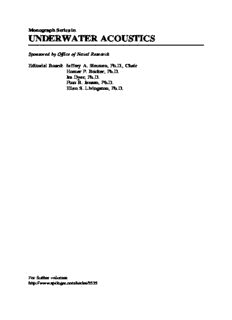
Fundamentals of shallow water acoustics PDF
Preview Fundamentals of shallow water acoustics
MonographSeriesin UNDERWATER ACOUSTICS Sponsored by Office of Naval Research Editorial Board: Jeffrey A. Simmen, Ph.D., Chair Homer P. Bucker, Ph.D. Ira Dyer, Ph.D. Finn B. Jensen, Ph.D. Ellen S. Livingston, Ph.D. Forfurther volumes: http://www.springer.com/series/5535 Monograph Series in UNDERWATER ACOUSTICS In 2001 the Office of Naval Research began a program to publish a selected monograph series in the field of underwater acoustics. The series publishes in-depth reviews and analysisonthestateofunderstandingofthephysicsofsoundinselectedareasofresearch. Themonographseriescoversthemostimportanttopicsinunderwatersoundinanin-depth, critical, scholarly,and comprehensive fashion. Itisintendedtoprovideresearchers withan understandingofthephysicsofunderwatersound,basedonboththeoryandexperiment.The discussionofimportantunansweredquestionsisencouraged.Topicsofparticularimportancein thefieldarelow-frequencysoundinthedeepocean,shallow-wateracoustics,andambientnoise. Sponsored by: Office ofNaval Research OneLiberty Center 875North RandolphStreet, Suite 1425 Arlington,VA22203-1995 E-mail:[email protected] Series Editors: JeffreyA.Simmen,Ph.D. HomerP. Bucker, Ph.D. AppliedPhysics Laboratory Space andNaval Warfare Systems Universityof Washington Center, retired 1013NE 40thStreet 808MoanaDrive Seattle,WA 98105-6698 San Diego,CA 92106 E-mail:[email protected] E-mail:[email protected] Ira Dyer,Ph.D. Finn B.Jensen, Ph.D. Weber Shaughness Professor Emeritus Scientist of Ocean Engineering, Emeritus NATO UnderseaResearch Centre Massachusetts Instituteof Technology 19126La Spezia,Italy Cambridge,MA 02139 E-mail:[email protected] Ellen S.Livingston,Ph.D. Associate Director Ocean and UnderseaScience U.S. Office ofNaval Research Global 86BlenheimCrescent West Ruislip,MiddlesexHA4 7HB UnitedKingdom E-mail:[email protected] Boris Katsnelson Valery Petnikov l James Lynch Fundamentals of Shallow Water Acoustics BorisKatsnelson ValeryPetnikov VoronezhStateUniversity A.M.ProkhorovGeneralPhysicsInstitute UniversitetskayaSquare1 RussianAcademyofSciences Voronezh349006,Russia Moscow119991,Russia [email protected] [email protected] JamesLynch WoodsHoleOceanographicInstitution WoodsHole02543,MA,USA [email protected] ISBN978-1-4419-9776-0 e-ISBN978-1-4419-9777-7 DOI10.1007/978-1-4419-9777-7 SpringerNewYorkDordrechtHeidelbergLondon LibraryofCongressControlNumber:2011944833 #SpringerScience+BusinessMedia,LLC2012 Allrightsreserved.Thisworkmaynotbetranslatedorcopiedinwholeorinpartwithoutthewritten permissionof the publisher (SpringerScience+Business Media, LLC, 233 SpringStreet, New York, NY10013,USA),exceptforbriefexcerptsinconnectionwithreviewsorscholarlyanalysis.Usein connectionwithanyformofinformationstorageandretrieval,electronicadaptation,computersoftware, orbysimilarordissimilarmethodologynowknownorhereafterdevelopedisforbidden. The use in this publication of trade names, trademarks, service marks, and similar terms, even if theyarenotidentifiedassuch,isnottobetakenasanexpressionofopinionastowhetherornotthey aresubjecttoproprietaryrights. Printedonacid-freepaper SpringerispartofSpringerScience+BusinessMedia(www.springer.com) Series Preface Theefficacyofsoundtopenetratetheseasmadeacousticsystemsinthepastcentury theleadingtoolsforsensingobjectsinandmeasuringpropertiesoftheseas.Forover 60 years, the US Office of Naval Research (ONR) has been a major sponsor of undersearesearchanddevelopmentatuniversities,nationallaboratories,andindus- trialorganizations.AppropriatelyONRisthesponsorofthismonographseries. The intent of the series is to summarize recent accomplishments in, and to outline perspectives for, underwater acoustics in specific fields of research. The general field has escalated in importance and spread broadly with richness anddepthofunderstanding.Ithasalso,quitenaturally,becomemorespecialized. Thegoalofthisseriesistopresentmonographsthatcriticallyreviewbothpastand recent accomplishments in order to address the shortcomings in present under- standing. In this way, these works will bridge the gaps in understanding among thespecialistsandfavorablycolorthedirectionofnewresearchanddevelopment. Eachmonographisintendedtobeastand-aloneadvancedcontributiontothefield. Wetrustthatthereaderwillalsofindthateachisacriticalintroduction torelated specializedtopicsofinterestaswell. ONRhassponsoredtheseriesthroughgrantstotheauthors.Authorsareselected by ONR based on the quality and relevance of each proposal and the author’s experience in the field. The editorial board, selected by ONR, has, at times, providedindependentviewstoONRinthisprocess.Itssoleofficialrole,however, istojudgethemanuscriptsbeforepublicationandtoassisteachauthorathisrequest throughtheprocesswithsuggestionsandbroadencouragement. JeffreyA.Simmen,Ph.D. HomerP.Bucker,Ph.D. IraDyer,Ph.D. FinnB.Jensen,Ph.D. EllenS.Livingston,Ph.D. v Preface and Acknowledgments Shallow water acoustics is a very active area of underwater acoustics research, as thecontinentalshelvesandslopeshavegreateconomic,social,andmilitaryimpor- tance to humans, and all these areas interact with ocean sound. However, books dedicated to this specific topic are in short supply, and indeed the book “Shallow Water Acoustics” published over two decades ago in Russian by the two Russian authors of this present book was the first volume specifically dedicated to this branch of underwater acoustics. The authors then had this book translated into English, and it represented the state of the art up toabout 1995. However,a huge amountofresearchhasbeendoneinthisareainthelast15years,andsowethought thatitwouldbeagoodthingforthethreeofustocollaborateonabookthatwould update the coverage of the field, as well as point out more strongly where we thoughtthefuturemightlie.AstheOfficeofNavalResearch(ONR)waspublishing abookseriesonunderwatersound,andwasamenabletotheidea,wesignedonwith themandproducedthisbook,guidedbyatechnicalEditorialBoardthatreviewed andcritiquedourwork. Itmayseemstrangetosomethatabookonunderwatersoundwaswrittenjointly by an American and two Russians, but in fact it is a rather natural development giventhehistoryofthelast50years.DuringtheColdWarera,boththeUSAand Russiadevelopedconsiderableexpertiseinunderwatersound,andhadlargecom- munities working in the area. And though (obviously) any transfer of classified workwasandisstrictlyprohibitedbybothcountries,thetransferofbasicresearch knowledge was and still is fairly open. Indeed, American researchers studied the works of the famous Russian acoustician Leonid Brekovskikh, while Russian researchers were just as familiar with the textbooks by Bob Urick and Clarence Clay.WhentheColdWarsubsidedinaround1990,actualmeetingsofRussianand Americaninvestigatorsbecamecommon,andindeedthatiswhenthethreeauthors ofthisbookfirstmet,ataportcalloftheRussianresearchvesselAkademikSergey VavilovinBoston,MA.Whatstruckusallwasjusthowmuchwehadincommon scientifically–wespokeonecommonlanguagewell,eveniftheRussians’English waspoorandtheAmerican’sRussiannonexistent.Wewereexcitedaboutthebasic vii viii PrefaceandAcknowledgments acousticsscience,andastheinternationaldoorshadopenedsufficiently,westarted tocollaborate. In the post-Cold War era, Russian support for experimental ocean acoustics droppedprecipitously,andseagoingeffortsbecamefewandfarbetween.However, a strong community with a good understanding of experiments and a sterling knowledge of theory existed, and started to look outwards for collaboration and funding.USfundingalsodroppedsome,butONRstillmaintainedavibrantocean acousticsprogram,includingastrongexperimentalandtechnologicalcomponent. GiventhedatacomingoutoftheUSprogram,andtheanalysiscapabilitiesofthe Russianresearchers,anaturalpartnershipwaspossible,andindeedcametofruition inmanycases,notjustforthisbook.Thisbitoftechnologicalsymbiosishasbeen goodforallconcerned,andweferventlyhopeitwillcontinue. Regardingthebookitself,wehavewrittenabookthatisintendedforgraduate students, postdocs, and more advanced researchers, that is also a cross between a researchmonographandatextbook.Astherearefewtextbooksinthisarea(seethe above remarks), we thought that covering the elements of the field, but at an advanced level, would be useful On the other hand, we also wanted to provide a monograph that showed the state of the art in research, and also tried to point the wayforfutureefforts.Thismadethebookabitofabalancingact,andwehopethat ithassucceeded. We also have couched much of the physics of this book in terms of the modal picture,whichwethinkisthemostnaturaloneforshallowwater.Thatisnottosay thatwehaveavoidedraytheoryorWKB,butthatouremphasishasbeenonlower frequencymodalwork.Wealsonotethatsomeofthephysicscanbeexplainedin theraypictureaswellasthemode,andindeedoneofourEditorialBoardmembers, Dr.IraDyer,isastrongadvocateoflookingatthingsthatway.Ourfeelingisthat, once you have understood the physics in one picture or the other, you can under- standitbothways–thepicturetranslationisnotsohard. One might also notice a bias in the experimental data discussed to the Barents Sea and the East Coast of the USA. This is because these are the places that were most frequented experimentally by the authors and their home Institutions (Voronezh State University, the General Physics Institute and the Woods Hole Oceanographic Institution). We are most familiar with the data from these areas, andsonaturallyusedthemfirstforexamples. Next,youwillnoteinreadingthisbookthatitspeakswithbothaRussianandan American (New Jersey) accent, depending on the section. We have tried hard to makethingsgrammaticallycorrect,andclearaswell,butthe“linguisticlilt”ofthe various sectionswe left intact.As all ofus are fans ofthe great physicist Richard Feynman, we think that speaking in your own voice is no crime, and has a noble precedent.Feynmanwouldhavecontended,aswedo,itiswhatyousayaboutthe science,andnottheregionalaccentthatcounts. Aswithanylargerpieceofwork,manypeoplewereinvolvedandcontributedto its completion. From the Russian side, the authors would like to acknowledge Fyodor V. Bunkin, Yuri A. Kravtsov, and the many other colleagues from the A.M. Phokhorov General Physics Institute and the Voronezh State University PrefaceandAcknowledgments ix whoseworkintheexecutionoflarge-scaleexperimentsontheshelfoftheBarents Sea and the interpretation of the results was invaluable. From the American side, theauthoralsowarmlyacknowledgesthenumerouscolleagueswithwhomhehas gone to sea, analyzed data, and argued over what it all means at meetings, work- shops, seminars, and other venues. Regarding funding, all the authors give their heartfeltthankstotheUSOfficeofNavalResearchandtheRobertW.MorseSenior ScientistChairatWHOI,bothofwhichpaidforthemajorityofthiswork.Fromthe Editorial side, the efforts of the Editorial Review Board (Drs. Ralph Goodman (deceased), Ira Dyer, Jeffrey Simmen, and Finn Jensen have been enormously helpful. The enthusiasm and project management of Dr. Ellen Livingston is also warmly appreciated. Also, our great thanks to Ms. Sheila Hurst for her editorial workandskills,andMs.GretchenMcManaminforheradministrativeassistance. Finally,ourthankstoourwivesandfamilies,whoputupwithouroftenerratic andtravelheavyoceanographerlifestyles,whichareprerequisitestowritingsucha book.Theonlyreallyhardthingaboutbeinganoceanographerisbeingawayfrom suchwonderfulfamiliesforlongperiodsoftime. Voronezh,Russia BorisKatsnelson Moscow,Russia ValeryPetnikov WoodsHole,MA,USA JamesLynch
Description: